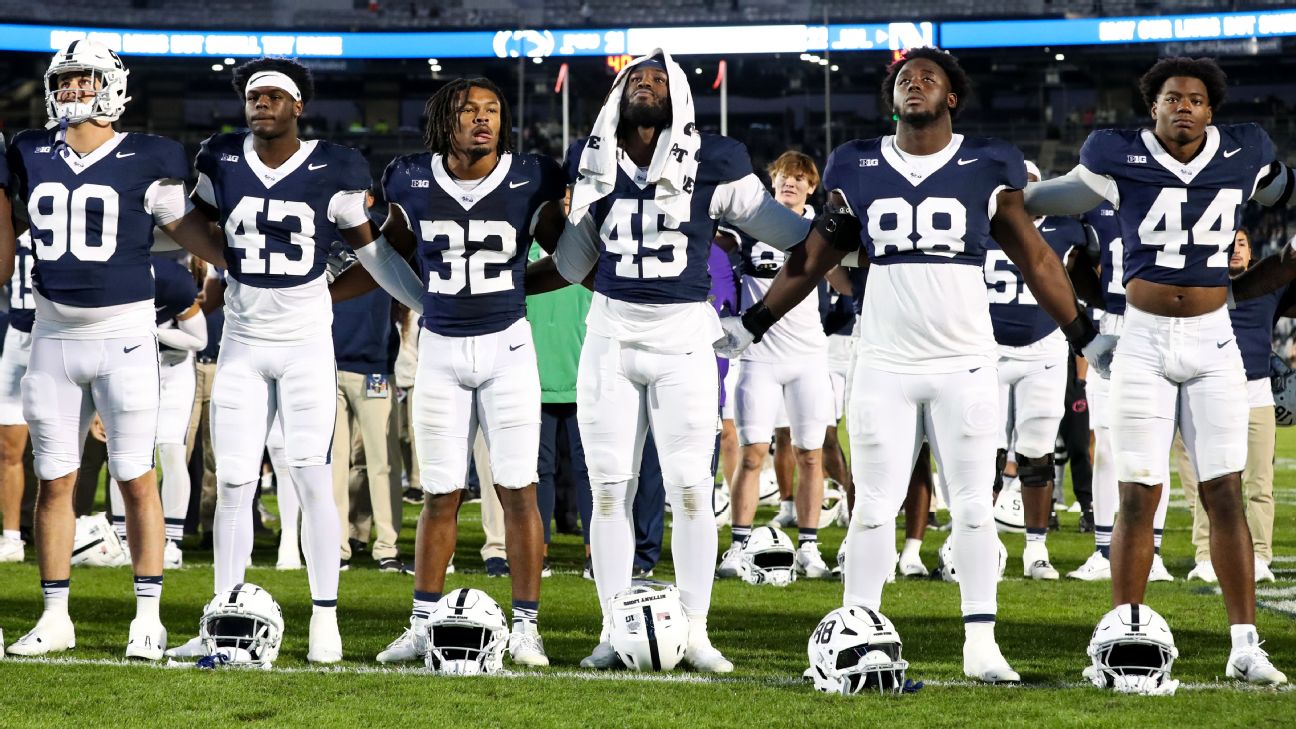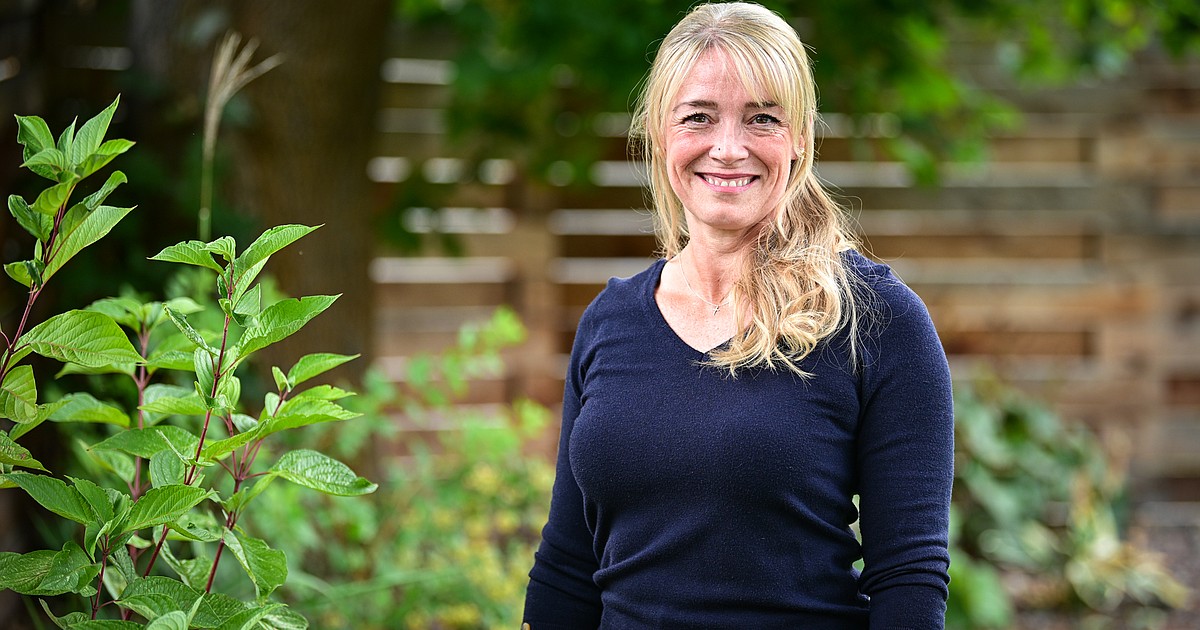Copyright KABC-TV

The 2025-26 coaching cycle wasn't expected to be calm, like its predecessor. But few forecasted such a robust line of storms rolling through the sport in the first half of the season. All four power conferences have had a firing. Penn State's ouster of James Franklin, midway through his 12th season and barely 10 months removed from the team playing for a spot in the national title game, sent a message around the sport: Almost no coach is safe. Franklin and Oklahoma State's Mike Gundy, fired Sept. 23 from his alma mater, have a combined record of 298-150 in the FBS. There are seven Power 4 schools looking for head coaches: Stanford, UCLA, Virginia Tech, Oklahoma State, Arkansas, Penn State and now Florida. Two other, notable, non-Power 4 jobs, Oregon State and UAB, are also on the hunt. More openings certainly could come, including Auburn and Kentucky in the SEC, Wisconsin in the Big Ten and Florida State in the ACC. And that's not even counting the inevitable vacancies that will occur when sitting head coaches leave for other jobs. The process of ranking the open jobs contains hard data, such as win-loss performance over time, recent postseason appearances and, while controversial to some, recruiting/transfer class rankings. The College Football Playoff is a major factor, both in terms of access and the varying pressure levels coaches face to be part of the 12-team field occasionally or regularly. Money matters more than ever in the sport, although accurately gauging each school's financial strength (or appetite) is tricky. They all say they're committed to winning. "It's a little bit different now than just saying, 'Oh, it's the SEC or the Big Ten,'" a coaching agent said. "It's about where can you be successful within your conference to have a chance to go to the playoff?" Leadership stability also resonates. How secure is the athletic director hiring the coach? University presidents move around much more frequently than they used to and have final say on major investments such as football coach hires. What's the presidential situation at these schools? The following Power 4 jobs rankings are based on the following five areas: Recent/historical on-field performance Access to CFP Roster-building/access to talent University leadership Financial support I tried to view these jobs as coaches do and ask: Which jobs offer the best path to success in the respective league? Which had the right mix of support and expectations? The SEC and Big Ten are the two most well-resourced leagues, but not every SEC or Big Ten job is better than every Big 12 or ACC job. Here's a look at the current rankings: 1. Penn State Nittany Lions Opened: Oct. 12 with firing of James Franklin On-field performance: PSU is 44-17 since the start of the 2021 season and 90-33 since the start of the 2016 season. The Lions won their most recent Big Ten title in 2016 and reached the league title game last season. They also made their CFP debut in 2024, beating SMU and Boise State before falling to Notre Dame 27-24 in a semifinal matchup at the Orange Bowl. Only seven other FBS teams have won more than 90 games since 2016, and Penn State has six 10-win seasons during that span. The team had six CFP top-12 finishes before making the expanded field. Penn State's last national title came in 1986. Access to CFP: As a Big Ten member, Penn State doesn't have to win its conference or, in some seasons, even reach the league title game, to qualify for the CFP. Franklin's teams certainly would have had more CFP appearances if the field was 12 teams earlier. But the Big Ten schedule is tougher, featuring road trips to the West Coast and the emergence of Indiana, a historic bottom-feeder, under coach Curt Cignetti. Penn State still has had -- and should have -- one of the league's most talented rosters, and certainly boasts a true home field when Beaver Stadium is fully activated, especially at night. Seasons of nine or more wins are realistic and attainable and, for the most part, will vault teams such as Penn State into the CFP mix. Roster-building: Penn State remains, by far, the most historically successful program in the Northeast, and can access recruiting hotbeds there as well as to the Southeast (Washington D.C. area) and to the West (Ohio, Michigan). "If you're doing it right, you've got Jersey, New York, you can reach into the DMV," a former Penn State staff member said. Penn State consistently has top-20 recruiting classes and has stepped up its investment for transfers, bringing in several notable wide receivers this offseason. The Lions had the No. 3 overall offseason and have proven they can retain top players and add new stars. University leadership: Pat Kraft is in his third year as athletic director and showcased the power he has obtained in making a difficult midseason coaching change. He's regarded as one of the nation's top athletic directors and views Penn State as a destination job after stints at Boston College and Temple. University president Neeli Bendapudi also has been in her role since 2022 and has shown a strong commitment to athletics and football, greenlighting key investments, including what will be a very expensive coaching transition. Franklin often recognized the support he received from both Kraft and Bendapudi. Financial support: A school doesn't make a front-end financial decision such as firing Franklin without being committed on the back end with his replacement and a top group of on-field assistants and supporting staff. Kraft made it clear that Penn State is positioned to compete for national championships. Beaver Stadium is undergoing a $700 million renovation, and Penn State has been aggressive in retaining top players, and adding key transfers and assistants such as defensive coordinator Jim Knowles. Penn State's upcoming apparel partnership with Adidas will bring increased revenues to athletics. Why the job ranks here: Despite a longer-than-expected national championship drought, Penn State has been very close to a breakthrough and has the financial structure to make the next step. The Big Ten is a bit deeper but doesn't have as many CFP-ready programs as the SEC. Penn State is undoubtedly one of them. 2. Florida Gators Opened: Sunday with firing of Billy Napier On-field performance: The lack of a single College Football Playoff appearance is jarring for a program that won three national championships between 1996 and 2008. Florida is 28-30 since the start of the 2021 season, tied for 84th nationally in winning percentage (.483). The Gators had three consecutive top-10 finishes in the CFP standings from 2018 to 2020 and would have made the field several times under former coach Dan Mullen if it were larger. But the team has largely floundered in SEC play in recent years, losing three or more conference games in eight of the past 12 seasons (not counting 2025). Access to CFP: The SEC affords Florida both a larger number of entry points and more profile-boosting opportunities. The league is also increasingly deeper, not only with the additions of Oklahoma and Texas, but with the emergence of teams such as Missouri and now Vanderbilt. Florida's rival Tennessee is coming off a CFP appearance, and perennial underachiever Texas A &M is the league's only unbeaten team in 2025. Plus, you have to deal with Alabama, Georgia, LSU and others. Florida will need to leapfrog several programs and hope some teams come back down to earth in the coming years. Roster-building: Talk to coaches who faced Napier's Florida's teams and it became clear that talent wasn't what held back the Gators. "They look pretty," an SEC coordinator said before facing Florida. "They've got good-looking players." Florida signed the nation's No. 10 recruiting class in both 2024 and 2025, headlined by players such as quarterback DJ Lagway, edge rusher LJ McCray and wide receivers Dallas Wilson and Vernell Brown III. Napier wasn't nearly as active in the portal, preferring to develop players through high school recruiting, but Florida's next coach should have the ability to push for more top transfers. University leadership: Most SEC athletic directors don't get a third chance at hiring a football coach after the first two don't pan out, but Florida's Scott Stricklin will have that opportunity here. Stricklin, who has led Florida's athletic department since 2016, received a contract extension last month that takes him through October 2030. Florida has excelled in other sports, including a men's basketball national title in April, but football has fallen short under Stricklin's watch. The university in August named an interim president in Donald Landry, after selecting Michigan's Santa Ono this spring, only to have the hire rejected. Florida hasn't had much stability since early 2023. Financial support: For years, Florida thrived on the field without making major investments in facilities and other key areas of the program. The frustration with the Napier era was that the university made commitments in multiple areas, and the team's performance still regressed. In his statement announcing Napier's firing, Stricklin said: "UF has never been more invested in the success of this football program -- elite facilities, robust NIL opportunities and comprehensive support for our student athletes and staff -- than we are today." But will that be enough? As a Florida staffer noted this week, "With money for the most part being equal going forward, this is not an elite job." Why the job ranks here: Florida is the only SEC program in a state loaded with talent and now has the financial infrastructure to support its coach as he chases a national championship. But the overall coaching churn and uneven results in Gainesville can't be ignored. 3. Oklahoma State Cowboys Opened: Sept. 23 with firing of Mike Gundy On-field performance: Two things can be true: The program has cratered since the start of the 2024 season, but Oklahoma State also played for a Big 12 title in 2023 and 2021. The Pokes also had seven 10-win seasons between 2010 to 2023. The Pokes are 33-26 since the start of the 2021 season -- 4-14 in the last season plus -- and are 76-46 since the start of the 2016 season. They are still one of the top remaining brands in a Big 12 Conference without Oklahoma and Texas, and recorded 10 AP Top 25 finishes between 2008 and 2023. Access to CFP: This category should boost the Oklahoma State job in the eyes of coaches and their representatives. The Big 12 doesn't have historic powers like the other three power conferences, and should have a wide-open race for one or more CFP spots in most seasons. In early 2022, Gundy was bullish about what Oklahoma State could become in a reshaped league, telling ESPN, "Put all the schools down on paper and look at the success they've had -- the wins, the bowl games, all the stuff -- over 15 years, then Oklahoma State should be leading the charge. I'm just going on success, the facts. That doesn't mean that we start on any higher level. What that means is if we push forward and make a strong commitment, then we could get to a high level in the new conference." Despite the recent struggles, he isn't wrong, and the right coach could soon help Oklahoma State rise again. Roster-building: Gundy's recruiting classes rarely popped on the national radar and seemed to fall off in recent years, but for a long time he consistently developed players, especially quarterbacks and wide receivers, and found talent within the state and in nearby north Texas. Oklahoma State can access the Dallas recruiting market and other regional hotbeds. The key is to have a stronger approach toward personnel, both high school recruiting and transfers, and the financial clout to attract and retain top players. Gundy's NIL comments ahead of the Oregon game clearly backfired on him, but Oklahoma State has to rally more financial support for its next coach to compete with Texas Tech and other Big 12 programs that have stepped up. University leadership: When Oklahoma State was rolling, the school had a stable (if combustible) triumvirate of Gundy, athletic director Mike Holder and super booster T. Boone Pickens. Even after Pickens died in 2019, there seemed to be enough alignment between Gundy, athletic director Chad Weiberg and university president Kayse Shrum, who led the university from July 2021 until February. Her surprising resignation, amid questions about how funds were appropriated, pushed Oklahoma State into a period of uncertainty. Weiberg's contract ended July 30 but he continued working as AD, and will remain in the role, president Jim Hess recently told The Tulsa World. Hess took over as interim president following Shrum's resignation but was named to the permanent role in April. He and Weiberg must project stability during the search and ultimately rally donors behind their selection. Financial support: Even after Pickens' death, Gundy believed in the financial muscle of Oklahoma State's booster base, telling ESPN in 2022, "There's a lot of Oklahoma State people that have done well in the corporate world and have money to invest and donate. But it really helps when you're winning and having success because people want to be a part of a winner." Oklahoma State hasn't been winning and Gundy is gone, so it's imperative for Weiberg and Hess to rally support behind the next coach. The school once was way ahead in facilities but fell behind with NIL and the areas needed to win in today's game."You've got fan attendance, you've got donors that just didn't like Gundy and are willing to spend," an industry source said. "And you got a conference that other than Texas Tech, your resources are going to be near the highest point." Why the job ranks here: If Oklahoma State has a strong plan, it should be able to rise fairly quickly in a league without behemoth brands. The team isn't far removed from CFP contention and can get there faster than other programs on this list. 4. Virginia Tech Hokies Opened: Sept. 14 with firing of Brent Pry On-field performance: The program's heyday under Hall of Fame coach Frank Beamer has faded a bit but remains more visible than others on this list. From 1993 to 2011, Beamer's teams went 185-58, ranking second behind Florida in wins and fourth in winning percentage (.761). Virginia Tech had AP Top 25 finishes in all but three years during that span, while winning seven conference titles and playing for a national title in 1999. Beamer's successor Justin Fuente had some initial success -- winning 19 games in his first two seasons -- but Virginia Tech hasn't won more than seven games in a season since 2019. Virginia Tech has a large and loyal fan base that can provide a top home-field advantage, but the team needs to give those people a reason to care. Access to CFP: Here's where the job could really pop, especially if the CFP field expands and there are more slots for the ACC to have multiple entries. Virginia Tech's best attribute is being a football-first school with a winning tradition that, if supported correctly with the right people in charge, could become a semiregular contender for league championships again. The ACC has more notable brands than the Big 12 does in Clemson, Florida State and Miami, but all have been vulnerable, even this season. And after those three, which program can match Virginia Tech's history and potential? "The climb to the top is not nearly as steep as the climb in those other leagues," a Virginia Tech source said. "If you're at Florida, Auburn or Arkansas, you're playing Ohio State every week. Here, you can play Wake, Georgia Tech and Boston College." Roster-building: Virginia Tech might never dominate regional recruiting like it did under Beamer, but its ability to access pockets of talent certainly remains. There are good players within the state, certainly in the Washington D.C. area, and Virginia Tech can also easily recruit North Carolina and Tennessee from its location. The key will be retaining players, as Virginia Tech saw cornerback Mansoor Delane and other notables from the 2024 team transfer out, and being increasingly more competitive for top transfers. University leadership: Whit Babcock has led Virginia Tech's athletic department since 2014 and hired both Fuente and Pry. But his true influence on the next coaching hire -- and the program at large -- is being debated. He has been visible in the campaign for additional athletics department funding, and last month the school's board added $229 million to the department's budget during the next four years. Coaches still should be asking pointed questions about how much longer Babcock remains in Blacksburg. University president Timothy Sands has also been in his role since 2014. He has a hands-on role in athletics and also serves as chair of the NCAA Division I Board of Directors. Financial support: Virginia Tech has never had trouble drumming up interest in its football program. It has lacked the finances to maintain its place in college football's hierarchy. But the recent board decision and upcoming budget increase could be a game changer, both for the type of candidate Virginia Tech attracts -- or, potentially, in Shane Beamer's case, bring back -- and how the program operates going forward. "We know that Virginia Tech is not going to be status quo, but they've still got to show some deliverables on that," an industry source said. "If Virginia Tech wasn't making this new $229 million cash infusion, you wouldn't think about it." Another industry source pointed out, "If you're Virginia Tech, you're never going to be resourced, like Miami, Clemson and Florida State." Why the job ranks here: Virginia Tech is a football school in a winnable conference that can take a significant step with newfound financial backing and the right coaching hire. 5. Arkansas Razorbacks Opened: Sept. 28 with firing of Sam Pittman On-field performance: Arkansas is the ultimate wild card on this list. The program has a great long-term history, including a 1964 national championship and an impressive run in the Southwest Conference from 1959 to 1989, which included 10 league titles and 19 AP top-20 finishes. But life in the SEC hasn't been kind to the Razorbacks, other than brief spurts under Houston Nutt and Bobby Petrino, and the recent results have been very poor. Since the start of the 2017 season, Arkansas is just 40-63 with only three winning seasons and just one with more than seven victories. The Hogs haven't had a winning record in SEC play since 2015, and the conference is only getting tougher. Access to CFP: Perhaps more than any other category, CFP access is a problem for Arkansas. SEC membership affords more opportunities to access the playoff, especially if and when the system expands in the coming years but think about how many teams Arkansas must rise beyond to work its way into contention. There are the SEC's traditional powers -- Alabama, Georgia, LSU, Tennessee, even Florida -- new additions with CFP credentials in Texas and Oklahoma, programs with more resources and better locations such as Texas A &M and Auburn, and emerging teams such as Ole Miss, Missouri, South Carolina and now Vanderbilt. Even if Arkansas can maximize its vast financial potential, it has so much competition for still a relatively small number of CFP spots. Roster-building: Arkansas doesn't have as large a pool of high-level in-state recruits as most other SEC teams. The Razorbacks need a strong hit rate on who they get, and then develop, retain and attract others to fill out their roster. Arkansas has historically accessed Texas but the presence of Texas A &M and now Texas and Oklahoma makes things harder. The team also looks to the Memphis area, as well as states such as Louisiana, Georgia, Florida and Alabama. "It's an awesome place," an industry source said. "They've got a great fan base, they've got a great home venue, they've got facilities. They've got a lot of things there. It's just, you've got few players in your state." University leadership: Athletics director Hunter Yurachek has been in his role since December 2017. He technically has hired two football coaches but wasn't overly involved in the search that landed Chad Morris until the very end. Yurachek, who made previous AD stops at Houston and Coastal Carolina, has made some bold moves at Arkansas, such as hiring John Calipari in men's basketball, Pittman in football and interviewing Deion Sanders for the football job. His recent comments about Arkansas' ability to compete for national championships in football drew criticism and a later clarification, so there's some tension around him. Charles Robinson has served as Arkansas' chancellor since November 2022 after an interim period. Financial support: There's a ton of money in northwest Arkansas and around the university, especially through the Walmart and Tyson Foods connections. The key is whether Yurachek and Arkansas can drum up enough support for football to give the program a better chance at competing with the SEC heavies. "Arkansas has the booster network that is capable of doing something significant," an industry source said. "I don't know if they will, but they can." Perhaps Yurachek's recent comments (and clarification) will be an inflection point for Arkansas' deep-pocketed stakeholders, as money is a differentiator for the program. "Historically, it's been one of the bottom jobs in that league, in terms of proximity to players and all those things," an industry source said. "But in this new era, it should be and could be a much better job than what it's been in the past, but it all hinges on the financial investment." Why the job ranks here: Despite success in other sports, Arkansas' backslide in football and position within an increasingly challenging conference creates a steep climb to CFP relevancy. Arkansas has definite growth potential but must improve at harnessing local financial support. 6. Stanford Cardinal Opened: March 25 with firing of Troy Taylor On-field performance: Recency bias factors in here, as Stanford not long ago was among college football's most consistently strong programs. From 2010 to 2017, Stanford went 85-23, tying for sixth nationally in best winning percentage (.787). The Cardinal had three straight AP top-7 finishes from 2010 to 2012, finished No. 3 in 2015 and finished outside of the AP top-20 just once. But the transfer portal/NIL era in the sport hasn't been kind to Stanford, which didn't adjust well and quickly slipped on the field. The dissolution of the Pac-12 and joining the ACC as a West Coast school has brought challenges, too. Stanford has had four consecutive 3-9 seasons. Although interim coach Frank Reich has outperformed expectations this year at 3-4, Stanford won't be favored in many games down the stretch. Access to CFP: The ACC doesn't have as many elite programs to climb over as the SEC or Big Ten, and should supply multiple CFP berths in most seasons. But Stanford has some significant challenges, especially its location and the strain of long road trips. The Cardinal will regularly travel multiple time zones away from campus, and face league members with more direct access to recruiting hubs such as South Florida, Atlanta, Dallas and Washington D.C. Stanford would have made the CFP several times if the field were 12, but regaining anywhere near that level of consistent excellence will be much tougher in this environment. Roster-building: Stanford is coming off of a hellish offseason that included the spring coaching change and the departures of several top players, including linebacker David Bailey (Texas Tech), wide receiver Emmett Mosley V (Texas) and quarterback Bear Bachmeier, now starting for undefeated BYU. On the flip side, Stanford recruited those players and seemed to be improving its roster. General manager Andrew Luck is all in and definitely a positive force for the program's future. But Stanford will always have its limitations, especially with transfers. The portal can't be such a net negative for the program to compete in the ACC. "If they can get back to recruiting good linemen, good tight ends, a good quarterback, defensive line, they're going to have the money you can get a Stanford kid that wants to be there," an industry source said. "The thing about Stanford is, if you can get kids, you can really develop them, because if they're there, they want the Stanford degree, so they're not going to transfer." University leadership: The arrival of new leadership in both Luck (hired in November) and athletic director John Donahoe, previously CEO at Nike, should elevate optimism about Stanford's future in football. Donahoe's business experience might be especially valuable. Then again, Stanford is an elite private school that sponsors 36 sports and wants to be great at all of them. Where does football really fall on the list of priorities? University president Jon Levin has been in his role since August 2024, after leading Stanford's business school as dean for the previous eight years. Financial support: Earlier this month, Stanford announced a $50 million gift from alum Bradford M. Freeman that will go to the football program. Levin called it a "game-changing gift," and Luck mentioned scholarships and institutional NIL in his statement. Stanford has financial streams but also one of the smaller fan bases in the Power 4, and a massive athletic department that wants to excel in basketball, baseball and the Olympic sports. The key will be upgrading the recruiting operation after its second coaching transition in three years -- after 12 years of David Shaw -- and keeping its best players on The Farm. Why the job ranks here: Stanford's recent on-field struggles, awkward placement in the ACC and limited recruiting pool creates some unavoidable obstacles, but Luck's leadership and a renewed commitment to the program generates genuine hope. 7. UCLA Bruins Opened: Sept. 14 with firing of DeShaun Foster On-field performance: UCLA hasn't completely bottomed out like some other programs on this list, but the team also hasn't won anything substantial in a generation. The Bruins' last conference title came in 1998, capping a stretch of three in six seasons. UCLA had five AP top-10 finishes between 1982 and 1988 and consecutive top-8 finishes in 1997 and 1998. But since then, the program has fallen mostly into irrelevance, while fan apathy has grown. The Bruins had only one AP Top 25 finish under Chip Kelly, billed as a transformational hire at the time, and haven't won 10 games in a season since 2014. They have posted a winning record in conference play just twice since 2016. Access to CFP: Just like the SEC, the Big Ten will afford its members more CFP slots, no matter how the format changes in the future. But UCLA has so many teams to climb over -- teams with more recent success, more fervent support and better resources. Of the four West Coast schools added to the Big Ten, UCLA lagged behind the other three in most key categories. Washington and Oregon have played for a national title in the playoff era, and USC has at least had three CFP top-10 finishes in the past decade. UCLA has finished in the final CFP standings just twice, and never higher than 14th. Roster-building: UCLA is the only current open job located right in the middle of a major recruiting hub. There's talent throughout Southern California, and UCLA has to get more top players to Westwood. DeShaun Foster made some brief recruiting inroads, and UCLA made a big personnel splash this spring by adding Tennessee quarterback transfer Nico Iamaleava, a Long Beach native. If UCLA continues to invest in transfers like Iamaleavea, it could move up in the Big Ten. But for far too long UCLA's location hasn't been the major advantage it should be. University leadership: There's a lot of attention on athletic director Martin Jarmond, who has been in his role since May 2020. He drew criticism for his handling of the last UCLA coaching transition, when Chip Kelly strung along the school before taking Ohio State's offensive coordinator role, leading to Jarmond's promotion of Foster, who wasn't on the head-coaching radar anywhere else. Chancellor Julio Frenk has been in his role since January, after nearly a decade as president at Miami, which increased its investment in the football program. "The biggest problem there is the [ University of California ] system, and the stadium," an industry source said. "Leadership, stadium resources are a real issue." Financial support: The good news is it's not as bad as it used to be. UCLA built a nice on-campus operations center, made a major coaching splash by hiring Kelly and flexed this spring with the Iamaleava transfer. But questions remain about UCLA's financial commitment, even if they're rooted more in perception than reality. Everyone has seen the pictures of a half-empty Rose Bowl, and the interest level in UCLA in the crowded Los Angeles sports and entertainment market seems lukewarm at best. Money certainly motivated UCLA's move to the Big Ten, and the school now must show its commitment to help its next coach. "UCLA can absolutely get behind the program and spend more money," an industry source said. "But I don't think they have the booster network to all of a sudden jump to the top quarter of the league in funding." Why the job ranks here: UCLA hasn't been consistently good for a long time and now plays on the Western flank of a conference with more top-tier programs that have fewer problems acquiring talent and filling their stadiums. ]



